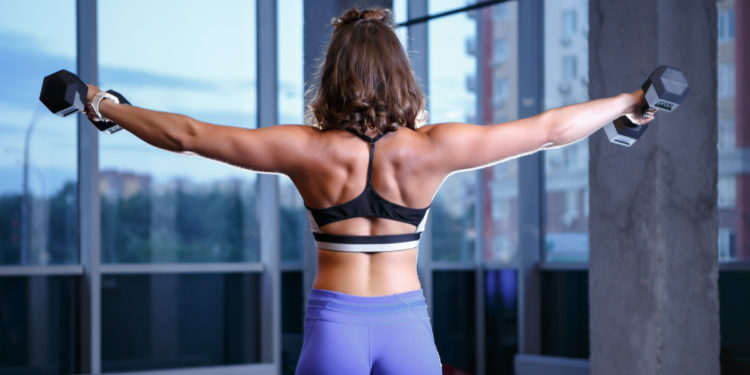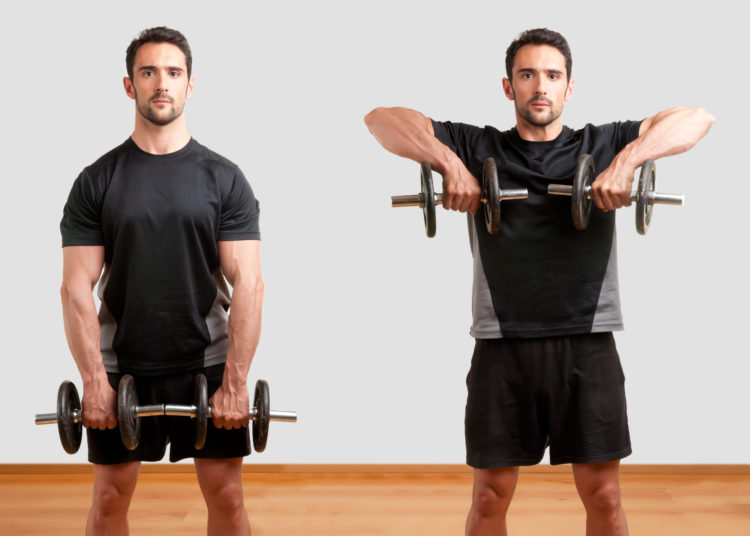When you’re a powerlifter and you think of pulling, your brain is most likely going to head right into deadlifting.
That makes a lot of sense: there’s really nothing like ripping a loaded barbell off the platform.
But if you’re a powerlifter and you’re not programming plenty of non-deadlift pulls into your routine, you might really want to make some adjustments. Stat.

Benefits of Upper Body Pulls
In a world where we sit over computers and hunch over our phones more often than not, upper body pulls are all-important. Even if you have histories of shoulder injuries and impingements that have made vertical pushes and pulls risky for you, there are plenty of shoulder-strengthening horizontal pulls you may well be able to do. (Of course, check with your doctor first.) Literally pulling your body backward, movements that encourage your shoulder blades toward each other, stimulate strong muscle activation across the lats, traps, and delts.
By reinforcing the strength of the core and upper body, pull exercises also stabilize your entire body, allowing you to become an even more efficient transmitter of force — and the more efficient you are at transmitting force, the better lifter you’ll become at the squat, bench, and deadlift.

Protecting Your Shoulders As A Powerlifter
Upper body pulls might not be any of our competition lifts, but pulling is still such an incredible way to strengthen your shoulders and protect yourself from injury.
Because you’re not paying enough attention to lifting mechanics if you think strong shoulders don’t stabilize your bench press, powerful traps don’t get your deadlift off the ground, and solid shoulder mobility doesn’t help lock the bar on your back for a squat. Protecting your shoulders by building them rather than neglecting them when the rest of your body is getting so strong can give your big three huge boosts.
You’re excited to get started, but you associate pulling with back exercises, not shoulders. Happily, there is some overlap between the two — what’s good for your traps tends to be good for your delts — and there are also some excellent pulling exercises that give a lot of direct attention to the rear delts.
[Related: 6 elite powerlifters share the most underrated accessory exercises]

Dumbbell Upright Rows
Some folks use barbells or EZ bars for upright rows, and that’s cool. But if your body isn’t shaped optimally for dragging a barbell up your front, or if you don’t have the wrist strength or attention to form you need to keep your wrists from yanking dangerously upward at the top of a lift, then dumbbell upright rows might be your new best friends.
Upright rows are spectacular for building powerful delts and traps, and doing them with dumbbells helps make sure you are working to smooth out any strength or flexibility imbalances.
- This lift involves holding a moderately heavy dumbbell in each hand with your palms facing toward you.
- After bracing your core, exhale while initiating a pull by lifting your elbows directly toward your ears while keeping tight near your rib cage.
- When you reach the movement’s capacity for your body (which is impacted by your body type, flexibility, and strength), the dumbbells will either be by your upper chest or your chin.
Training Recommendation:
3×8, moderate weight, 45-second rest.
[Related: The complete guide to the dumbbell upright row technique]
TRX YTWL Rows
Find the position from which you’re comfortable doing TRX rows. (If you’re not accustomed to doing these slightly unstable and therefore totally awesome inverted rows, you’ll want to try out TRX rows out before diving into YTWLs.) Let yourself stand slightly more vertical than you would for a full bodyweight row so you have more leniency with which to learn a new move.
- Grasping the TRX handles so that your palms are facing each other and keeping your core, glutes, and quads tight, initiate the “Y” part of the exercise by drawing your arms back (soft elbows, leading with scapular engagement) at about a 45-degree angle, so that your arms form something of a “Y.”
- For the “T,” keep soft elbows but your arms should be mostly straight as you draw your arms behind you (in a “T” shape with your body), essentially pulling yourself up toward the TRX connection point.
- For the “W”, of course, you’re making a “W” with your arms by keeping your palms forward and bending your elbows down as you pull yourself up to the TRX connection point, making a “W” shape.
- Lastly, the “L” will have your upper arms straight out to the side of your body and the forearms vertical, making an “L” shape. For these, the upper arms stay more or less stationary as the upper arms swivel forward and upward, as seen in the video above.
- With slow, steady control, lower your body back down to starting position by letting the fly movement rest. That’s one rep.
Training Recommendation:
3×4, 1-2-2-1 tempo, 45-second rest.
Wide Grip Barbell Rows
Your range of motion will be shorter than what it is with regular barbell rows, but this wider grip will help you isolate your rear delts during the movement. Even though this is an upper body pull, it might help to make sure your hamstrings are extra awake, especially if they tend to be tight.
- Make sure your back stays neutral and your hips are in a deep hinge throughout the entire movement.
- While a small bit of momentum to kick off the lift is alright, you definitely don’t want to be yanking the barbell up, and you certainly don’t want to turn a controlled back pull into an overexaggerated (and dangerous) hip hinge.
- Focus on initiating the movement (and completing it) by squeezing your shoulder blades together, and you’ll get an efficient pulling exercise for sure.
Training Recommendation:
3×8, 1-2-2-1 tempo, 60-second rest.
Reverse Flyes
Once again, start with a solid hip hinge and a neutral back. You’ll again want to make sure your hamstrings are warm and ready to stabilize your lower body.
- With soft elbows but not quite fully-bent arms, once again initiate the movement by imagining squeezing your shoulder blades together.
- Because you’re doing this with dumbbells, this is a good opportunity to make sure your shoulders are both getting equal attention and opportunities for growth.
- Most find that they need to use a lot less weight than they expected to finish the prescribed reps.
Training Recommendation:
3×10, 45-second rest.
Face Pulls
- By using a cable pulley and tricep pushdown rope set just above face height, stand while leaning slightly back with a braced core.
- With one hand on each rope handle, slowly and with control draw your elbows back along your ears like you’re stringing a bow.
- Leading with your shoulder blades (there’s definitely a theme here), pull until your wrists just about reach your ears, and then slowly return to start position.
Training Recommendation:
3×12, 35-second rest.
[Related: A 4-move circuit for a bulletproof rotator cuff]

Programming Shoulder Pulls
How do you program these moves into your already-packed training schedule? Of course, that all depends on your specific goals — are you looking to build mass? Develop or maintain basic shoulder health? — but some general programming guidelines are typically useful across the board.
Pull More Often Than You Push
Yes, you want your shoulders to be strong, but you also need them to be stable. To do that, you need to pull more often than you push. Developing strong rear delts and upper traps is not only helpful but necessary for maintaining the integrity of your upper body and core while you’re busy building a powerful chest.
And since you’re likely to spend so many hours every day hunched over your phone and/or computer, focusing on strengthening your upper back and shoulders with pulls — that stretch your anatomy back instead of curled over forward — can help combat the effects of your desk job.
Pull Before You Push
Because of the shoulder-saving potential of controlled pulling, doing some pull exercises before you push (pull-ups before overhead presses, for example, or reverse flyes before close grip presses) might be just the trick you need to help program yourself into some great painless lifting days. This is because pulling can improve your scapular stability enough to make a safer environment for pushing movements. And a safer environment for a bench press means a much more powerful bench press, so really, nobody loses.
Recover Between Sessions
Just because you’ll be wanting to pull often once you’ve come to the dark side (we have cookies and great traps) doesn’t mean you can train hardcore upper body pulls on the daily. You want to make sure you’re giving your muscles time to recover, so program your upper anterior muscles like you would any other: pay specific attention to how long your body typically takes to be prepped for another workout of the same muscle groups (often between 48 and 72 hours), and make your program accordingly.
[Related: How often should I train shoulders to build muscle?]
The Takeaway
To be a truly well-rounded powerlifter, you need to do more than squat, bench, and dead. Building strong shoulders is key to giving you competitive advantages over lifters who don’t think outside of the big three.
Integrating serious upper body pulling for shoulders into your program is also a super fun way to throw some variety in there, for both your body and your mind. And that’s really what we’re out here lifting for, isn’t it?
Editor’s note: This article is an op-ed. The views expressed herein and in the video are the author’s and don’t necessarily reflect the views of BarBend. Claims, assertions, opinions, and quotes have been sourced exclusively by the author.
Featured image via @sportpoint/Shutterstock